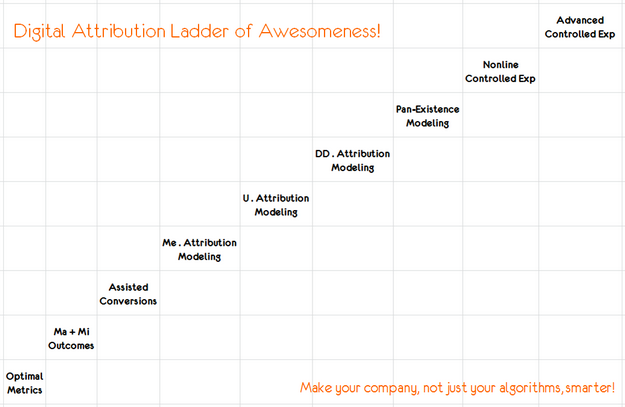Introduction
Marketing attribution modeling and incrementality go side by side. Without incrementality, you can’t build an effective, result-oriented model. There are many types of marketing attribution modeling, including Last-click, Time Decay, Data-driven, etc. A business must choose the modeling strategy that suits its goals.
Your marketing team may have members with different skill sets. Yet, you can be short of the resources required to do all the analytics work. Sometimes, it’s the unskilled employees. The other time it’s the tight project budget. Either way, you must be super careful about your business workflow.
One poor analytical decision can compromise your entire year’s ROI.
Marketing attribution modeling and incrementality start with analyzing data. It can be a game changer. When people, processes, and structures align with data and technology, the results are mind-blowing. You won’t have to cobble through data from multiple sources or spend time making spreadsheets.
It’s important to gradually build a strong foundation of people, processes, structure, and sophisticated data analytics and business intelligence systems. Then, you can move on to developing solid marketing attribution modeling with maximum incrementality.
Let’s start our evolutionary journey step-by-step.

What Is Marketing Attribution Modeling?
Marketing attribution or multi-touch attribution modeling is an analytical reporting strategy many marketers and sales teams use. It helps them determine a marketer’s impact on a specific goal, typically a sale or purchase.
For example, suppose you work at a SaaS company and are leading a marketing team. You have to launch a large-scale digital marketing campaign to promote your company’s software. You decide to distribute your marketing budget across three performance marketing platforms: Facebook, LinkedIn, and Google Ads.
The campaign is successful and receives a positive response. However, when you check your reporting tool, Google Analytics, you only see half of the results. For example, it tells you that you got more than 1,000 conversions from Facebook.
This is because of last-click attribution – the full credit for a conversion goes to the last touchpoint. The model assumes that it was the last touchpoint that made the buyer take action.
But what about LinkedIn and Google Ads? They must have contributed to the success of the campaign, right? This is where marketing attribution modeling comes in.
You can use data-driven attribution (DDA) on Google Analytics to allocate credit to Facebook, LinkedIn, and Google Ads based on the 1,000 conversions. Let’s say DDA shows a 40-30-30 or 50-20-30 attribution combination. This allows you to distribute your marketing budget more evenly across all three platforms, rather than just focusing on Facebook.
In summary, marketing attribution modeling helps businesses understand the effectiveness of their marketing efforts. Plus, it helps marketing execs allocate credit to the different channels used in a campaign. This can help them optimize their marketing strategy and budget for maximum results.

How is Incrementality any different from Marketing Attribution Modeling?
Incremental analysis is a key aspect of marketing attribution modeling. It helps businesses understand the true value of their marketing efforts by measuring the net new conversions generated by a campaign. This is in contrast to traditional marketing attribution modeling, which only considers the attributed conversions – that is, the conversions that are directly attributed to a particular marketing touchpoint.
For example, in our SaaS campaign, we may have generated 1,000 attributed conversions. However, using incremental analysis, we can determine how many of those conversions were truly incremental – that is, how many of those conversions would not have happened without the marketing campaign. This can help us understand the true value of our marketing efforts and make more informed decisions about our marketing budget and strategy.
As a rule of thumb, marketing incrementality usually ranges from 0% to 25% of the conversions. It is closer to 0% when your marketing efforts are targeting existing customers or when the campaign is reaching prospects who were already considering your product. On the other hand, it is closer to 25% when your marketing efforts are reaching completely new prospects who are not already aware of your product.
By understanding incrementality, businesses can optimize their marketing efforts for maximum results and make more effective use of their marketing budget. This can help them drive more sales and improve their overall return on investment (ROI).
Is Attribution Acceptable Without Incrementality?
Not really. Without considering incrementality, marketing attribution modeling can produce unreliable and inaccurate results and be considered a “poor data-driven marketing strategy”.
Let’s consider our SaaS campaign example. Suppose your attribution model reports that LinkedIn needs a 40% increase in the marketing budget based on 1,000 claimed conversions. However, if we don’t consider incrementality, we can’t be sure if all of those conversions were truly incremental – that is, if they wouldn’t have happened without the marketing campaign.
Any decision made based on marketing attribution modeling without considering incrementality is essentially pointless. It is like using the old-school last-click attribution model, which only considers the last touchpoint in a conversion process. The results will not be reliable or accurate.
For example, let’s say our incrementality is 5% for the SaaS campaign. This means that only 50 of the 1,000 claimed conversions were truly incremental. This is a significant difference, and it can have a major impact on how we allocate our marketing budget. If we don’t consider incrementality, we may be wasting resources on non-incremental conversions.
Furthermore, relying on attribution modeling without incrementality can be costly and wasteful. If we pay a third party to develop a marketing attribution model without considering incrementality, we may end up spending a lot of time and resources on a model that doesn’t provide accurate or useful results.
In summary, attribution modeling and incrementality must go hand in hand. We should only do attribution modeling after considering incrementality, and if our incrementality is 5% or below, we may be wasting resources on most of our claimed attributions.
Digital Marketing Attribution Modeling: 9 Key Steps
Building an efficient marketing attribution modeling strategy isn’t a one-day job. It is a gradual process that takes time, effort, and resources. Here are 9 critical steps to achieve it:
Choose the Right Metrics

The first step to effective attribution modeling is to choose the right metrics. These should be tough, smart metrics that actually tell you if the business is doing well. For example, you could use metrics such as indexed increase in brand awareness or customer lifetime value. Using these metrics instead of basic activity metrics like visits and time can help create the cultural and thinking sophistication required to do harder things.
Consider Macro and Micro-Outcomes
In addition to the typical macro-outcomes, such as sales or subscriptions, it is also important to consider micro-outcomes. These are smaller actions that can indicate a user’s engagement with your brand, such as downloading a white paper or signing up for a free trial. By optimizing for a portfolio of outcomes, rather than just one, SaaS businesses can make more sophisticated decisions about their marketing strategy.
Understand Path Metrics
The path metrics report in Google Analytics 4 shows how different marketing channels assist in conversions, allowing you to see the full value of each channel and make more informed decisions about budget allocation. This report provides valuable insights into which channels are most effective at driving conversions and can help you optimize your marketing efforts.
Develop a People, Process, and Structure Foundation
In order to optimize for a portfolio of outcomes, SaaS businesses must have a strong foundation of people, processes, and structure. This means having the right team with the right skills, as well as well-defined processes and structures in place to support data-driven decision making. Without this foundation, it will be difficult to effectively implement attribution modeling.
Start with Marketing Attribution Modeling Basics
Once you have the right metrics and foundation in place, you can start with basic attribution modeling. This could involve using a model like Last-Interaction or First-Touch to get a sense of how your marketing channels are performing. This can provide valuable insights into which channels are most effective at driving conversions, and can help you make initial decisions about budget allocation.
Use Data-Driven Attribution Modeling
Data-driven attribution is a more advanced modeling method that uses machine learning to assign credit to different marketing channels based on their actual performance. This allows SaaS businesses to make more accurate decisions about which channels are truly driving conversions, and can help optimize the allocation of marketing resources.
Understand Incrementality
While attribution modeling can provide valuable insights into how different channels contribute to conversions, it is also important to understand incrementality – that is, the true value of your marketing efforts. This is measured by the net new conversions generated by a campaign, and can help businesses understand the true impact of their marketing efforts.
Use a Combination of Attribution Models
Different attribution models can provide valuable insights, so it can be helpful to use a combination of models to get a more complete picture of your marketing performance. For example, you could use Last-Interaction attribution to understand the immediate impact of your marketing efforts, and data-driven attribution to understand the longer-term value of different channels.
Continuously Optimize and Improve
Attribution modeling is an ongoing process, and it is important to regularly review and update your strategy. This could involve using new or different models, or adjusting your budget allocation based on the insights from your attribution analysis. By continuously optimizing and improving your attribution strategy, you can improve the effectiveness of your marketing efforts and maximize your return on investment.
Using Google Analytics 4, you can access the Attribution reports under the “Attribution” section in the left-hand menu. This will provide you with a range of attribution reports, such as Assisted Conversions and Path Length, which can help you understand the full value of your marketing channels and make more informed decisions about budget allocation.
Overall, attribution modeling is a powerful tool for SaaS businesses looking to optimize their marketing efforts and drive more conversions. By following these 9 steps, you can build a strong foundation for your attribution strategy and make data-driven decisions that will help you maximize your return on investment.
Conclusion
In conclusion, marketing attribution modeling is an essential aspect of B2B data-driven marketing. By understanding the true value of their marketing efforts and allocating credit to the different channels used in a campaign, businesses can optimize their marketing strategy and budget for maximum results. Incrementality is a key component of effective attribution modeling, and businesses should carefully consider it when developing their attribution strategy. With the right tools and expertise, businesses can gain valuable insights and drive better marketing outcomes.
At Maya Insights, we understand the importance of marketing attribution modeling and incrementality. Our platform can help businesses with their data-driven marketing efforts, cluster their data and provide valuable insights into the true impact of their campaigns. Try Maya today and see the difference it can make for your business.
Frequently Asked Questions
Marketing attribution modeling is an analytical reporting strategy that helps businesses understand the effectiveness of their marketing efforts. It allows businesses to allocate credit to the different channels used in a campaign, which can help them optimize their marketing strategy and budget for maximum results.
The main difference between marketing attribution and incrementality is that marketing attribution is a broader concept that refers to the process of allocating credit to different channels, while incrementality specifically refers to the measurement of the net new conversions generated by a campaign. In other words, incrementality is a key aspect of marketing attribution that helps businesses understand the true value of their marketing efforts and make more informed decisions about their marketing budget and strategy.
To develop an efficient digital marketing attribution strategy, businesses should start by building a strong foundation of people, processes, structure, and data analytics systems. They can then use a marketing attribution model that takes into account incrementality, such as data-driven attribution, to allocate credit to different channels and optimize their marketing budget and strategy. It may also be helpful to work with a specialized marketing attribution software provider to ensure accurate and effective implementation. In addition, businesses should regularly review and update their attribution strategy to ensure it continues to align with their goals and the evolving digital marketing landscape.